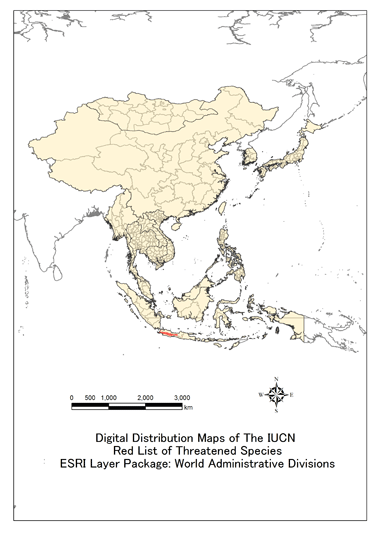
TOP > 生物多様性センターの国際協力 > ESABII > Database > Threatened Mammal Species Database > Presbytis comata

Presbytis comata
Taxonomy (Name)
| Class | MAMMALIAIUCN | |
|---|---|---|
| Order | DIPROTODONTIAIUCN | |
| Family | CERCOPITHECIDAEIUCN | |
| Scientific Name | Presbytis comataIUCN | |
| Author | Desmarest, 1822IUCN | |
| Synonyms | Presbytis fredericae (Sody, 1930) IUCN | |
| Common Name | Javan Surili, Grizzled Leaf Monkey, Java Leaf Monkey, Javan Grizzled LangurIUCN | |
| Local name | Brunei Darussalam | |
| Cambodia | ||
| China | ||
| Indonesia | ||
| Japan | ||
| Lao PDR | ||
| Malaysia | ||
| Myanmar | ||
| Mongolia | ||
| Philippines | ||
| Singapore | ||
| Republic of Korea | ||
| Thailand | ||
| Vietnam | ||
Picture
Distribution, Range
This species is found in western and central Java (as far east as the Gunung Slamet region) in fragmented pockets (Groves 2001).
Map


Country
| Brunei Darussalam | |
|---|---|
| Cambodia | |
| China | |
| Indonesia | |
| Japan | |
| Lao PDR | |
| Malaysia | |
| Myanmar | |
| Mongolia | |
| Philippines | |
| Singapore | |
| Republic of Korea | |
| Thailand | |
| Vietnam |
Status
International Status
IUCN Red List Category
ENIUCN
Justification
Listed as Endangered because its population size is estimated to number fewer than 2,500 mature individuals, there is a continuing decline in the number of mature individuals, and no subpopulation contains more than 250 mature individuals.
CITES
CMS
National Status
| Country | Category | Reference |
|---|---|---|
| Brunei Darussalam | ||
| Cambodia | ||
| China | ||
| Indonesia | ||
| Japan | ||
| Korea | ||
| Lao PDR | ||
| Malaysia | ||
| Mongolia | ||
| Myanmar | ||
| Philippines | ||
| Singapore | ||
| Thailand | ||
| Vietnam |
Ecology Discription
Appearance
Habitat
This species was historically found from sea level to 2,565 m (V. Nijman pers. comm.), but is now mainly restricted to mountain habitat fragments. In the Pegunungan Dieng it is found in primary and secondary forests, at the edges and in the interior, and in lowland forests, forests on steep slopes and hills, and upper montane forest (Nijman and van Balen 1998).
Population size
Population size has been estimated at between 2,285 (Supriatna et al. 1994) and 2,500 animals (MacKinnon 1996) in approximately 30 isolated populations. However, there remains some disagreement as to the actual number of individuals currently remaining.
Behavior
Diet
It is folivorous, but will also consume fruits, flowers, and seeds (Ruhiyat 1983).
Reproduction
Threat
Major Threat(s)
Presbytis comata is threatened by habitat destruction (Nijman and van Balen 1998), such that the remaining populations are now mainly confined to montane forest patches, whereas the species once occurred across extensive lowland areas. Hunting is a persistent threat in many of the remaining population fragments.
Conservation and Measurement
International
This species is listed on CITES Appendix II.IUCN
National
Most remaining populations in western Java exist in nature preserves where they are mostly safe from habitat disturbance and hunting. Most populations seem to have stabilized, and although they are fragmented, some retain large numbers of individuals.
Conservation law
| Country | Status | Reference |
|---|---|---|
| Brunei Darussalam | ||
| Cambodia | ||
| China | ||
| Indonesia | ||
| Japan | ||
| Korea | ||
| Lao PDR | ||
| Malaysia | ||
| Mongolia | ||
| Myanmar | ||
| Philippines | ||
| Singapore | ||
| Thailand | ||
| Vietnam |
Protected Area
Ujung Kulon National Park, Halimun National Park, and Gede-Pangrango National Park (Nijman 1997).
Other Coservation Projects
Citation
Brandon-Jones, D. 1984. Colobus and leaf-monkeys. In: D. Macdonald (ed.), The encyclopedia of mammals, pp. 398-408. Facts on File, New York, USA.
Brandon-Jones, D. 1995. Presbytis fredericae (Sody, 1930), an endangered colobine species endemic to central Java, Indonesia. Primate Conservation 16: 68-70.
Groves, C. P. 2001. Primate taxonomy. Smithsonian Institution Press, Washington, DC, USA.
Groves, C. P. 2005. Order Primates. In: D. E. Wilson and D. M. Reeder (eds), Mammal Species of the World, pp. 111-184. The Johns Hopkins University Press, Baltimore, Maryland, USA.
MacKinnon, M. 1986. The conservation status of nonhuman primates in Indonesia. In: K. Benirschke (ed.), Primates. The road to self-sustaining populations, New York and Berlin.
Melisch, R. and Dirgayusa, I. 1996. Notes on the grizzled leaf monkey (Presbytis comata) from two nature reserves in west Java, Indonesia. Asian Primates 6(1-2): 5?11.
Nijman, V. 1997. Geographic variation in pelage characteristics in Presbytis comata (Desmarest, 1822) (Mammalia: primates, Cercopithecidae). Z. Saugetierk. 62: 257?264.
Nijman, V. 1997. On the occurrence and distribution of Presbytis comata (Desmarest, 1822) (Mammalia: primates, Cercopithecidae) in Java, Indonesia. Contributions to Zoology 66(4): 247?256.
Nijman, V. and Sozer, R. 1995. Recent observations of the grizzled leaf monkey (Presbytis comata) and extension of the range of the Javan gibbon (Hylobates moloch) in central Java. Tropical Biodiversity 3(1): 45 ? 48.
Nijman, V. and van Balen, S. 1998. A faunal survey of the Dieng Mountains, central Java, Indonesia: distribution and conservation of endemic primate taxa. Oryx 32(2): 145 ? 156.
Ruhiyat, Y. 1983. Socio-ecological study of Presbytis aygula in west Java. Primates 24(3): 344-359.
Sody, H. 1937. Pithecus aygula fredericae n. subsp. Natuur 19: 68.
Supriatna, J., Tilson, R., Gurmaya, K., Manansang, J., Wardojo, W., Sriyanto, A., Teare, A., Castle, K. and Seal, U. 1994. Javan gibbon and Javan langur: Population and habitat viability analysis report. IUCN / SSC Conservation Breeding Specialist Group, Apple Valley, Minnesota.
Weitzel, V. and Groves, C. 1985. The nomenclature and taxonomy of the colobine monkeys of Java. International Journal of Primatology 6(4): 399 ? 409.
